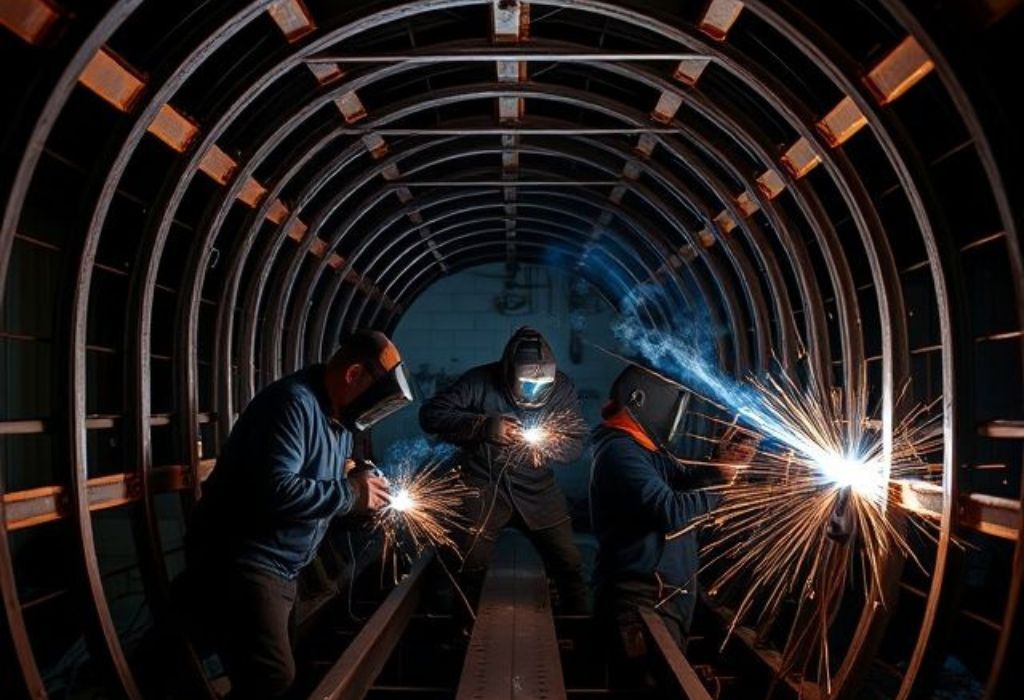A sudden spark, a bright arc, and the workshop hums with energy. In that moment, electronics sitting a few feet away might flicker—or worse, suddenly die. Could performing a weld send a destructive pulse through the circuits in your control panel or computer?
Many technicians never imagine their precision equipment is at risk. Yet stray voltage from arc welding has been known to travel through wiring, corrupting data or frying components.
When high starting voltages of 400 V or more during orbital welding propagate through interfaces into active systems, outcomes may be disastrous. llis.nasa.gov
Arc welding is inherently noisy, electrically speaking. A recent dataset from NIST reveals that TIG welding produces electromagnetic interference (EMI) signals measured at frequencies overlapping 900 MHz, 2.4 GHz, and 5.3 GHz—bands commonly used in modern wireless systems. NIST
What Does “Damage” Mean? Definition & Risk Zones

When discussing can welding machine damage electronics, “damage” can mean anything from a brief data glitch to a total hardware failure. In some cases, a single voltage spike can silently corrupt firmware or melt micro-components without any visible trace.
Electronics are vulnerable in different ways. Sensitive circuits such as microcontrollers, PLCs, and ECUs can be affected by electromagnetic interference (EMI), electrostatic discharge (ESD), or stray current returning through the same grounding path.
In an industrial or workshop environment, the danger grows where power cables, data lines, and welding leads share close proximity. Every time a welder strikes an arc, transient surges ripple through the network, seeking the easiest conductive route.
These routes, known as risk zones, often include connected outlets, unshielded cables, or improperly grounded panels. Even devices turned off but still plugged in can experience voltage induction strong enough to degrade internal components over time.
Ground loops are another silent threat. When multiple ground points exist at different electrical potentials, welding current can pass between them, producing a destructive potential difference that attacks the weakest link—often an electronic board.
Now let’s clarify the most common situations where damage occurs and how each risk zone amplifies the problem.
Can welding machine damage electronics permanently?
Yes. If stray voltage or surges reach delicate components, irreversible hardware damage can occur.
Can welding machine damage electronics via EMI?
Absolutely. Arc ignition produces strong RF interference that can disrupt or destroy unshielded circuits.
Can welding machine damage electronics at distance?
Yes, within a few meters. EMI fields and shared grounds can transmit energy into nearby devices.
Can welding machine damage electronics in vehicles?
Yes. Vehicle ECUs and sensors are extremely sensitive to voltage transients generated during welding.
Can welding machine damage electronics even when off?
Yes, if still plugged in. Induced voltage through shared lines can affect dormant circuits.
Underlying Mechanisms: Why a Welding Machine Can Damage Electronics
Welding machines generate intense electrical activity. Each time the arc ignites, it produces voltage spikes, magnetic fields, and electromagnetic interference (EMI) that radiate in every direction.
These emissions can couple into surrounding cables or circuits. Sensitive electronics such as PLCs, sensors, and computers are especially vulnerable when these disturbances overlap their operating frequencies.
One major culprit is high-frequency (HF) start, commonly used in TIG welders. HF systems send bursts of thousands of volts to initiate the arc without direct contact, but those same bursts can induce currents in nearby electronics and data lines.
When current paths are not properly isolated, stray current finds alternative routes. It may travel through grounding cables, communication wires, or even metallic structures connecting electronic equipment.
Poor grounding compounds the issue. A single loose clamp or improperly connected return cable can create a ground loop, allowing current to circulate unpredictably between systems.
Over time, these surges and induced voltages lead to cumulative degradation. Capacitors weaken, insulation breaks down, and logic boards fail without an obvious cause.
How does EMI from welding affect electronics?
It injects unwanted electrical noise into circuits, disrupting signals or causing component failure.
Does high-frequency TIG increase the risk?
Yes. HF start generates powerful RF bursts that easily interfere with sensitive digital devices.
Can stray current travel through control circuits?
Yes. If return paths are shared or poorly grounded, welding current can pass through electronic boards.
Do transformer and inverter welders differ in risk?
Yes. Inverters have better filtering but can still emit EMI if shielding or grounding is inadequate.
Can welding near network cables cause issues?
Yes. Long Ethernet or signal cables act like antennas, capturing interference from the arc.
Real-World Examples & Evidence
In workshops and factories around the world, small welding mistakes have led to surprisingly costly failures. Many of these incidents happen not because of carelessness, but because the electrical interactions between welding machines and nearby electronics are misunderstood.
One machinist reported that his CNC controller randomly reset every time TIG welding began on the same circuit. The cause was traced to electromagnetic interference radiating from the high-frequency start system.
In another case, a garage door opener’s control board failed completely after multiple welds were performed near its wiring. The board’s low-voltage circuits absorbed the stray current from a poorly grounded return path. (Reddit Welding Forum)
Industrial plants have experienced far greater losses. Programmable Logic Controllers (PLCs) and sensors on automated lines have burned out when workers welded on powered machinery without disconnecting control circuits. (PLC Talk Forum)
Even computers positioned several meters away have been damaged by radio-frequency energy or surges conducted through shared outlets. A single welding session was enough to destroy a power supply unit and corrupt hard drive data.
These examples demonstrate that can welding machine damage electronics is not a hypothetical concern. It is a proven risk across industrial, automotive, and home settings when electrical safety steps are ignored.
Can a welder interfere with a PLC?
Yes. The arc’s EMI and stray voltage can trigger false inputs or burn internal circuits.
Has a welding machine damaged a computer before?
Yes. Real reports show failures in power supplies, graphics cards, and motherboards.
Do such incidents occur often?
They are uncommon with proper grounding, but frequent in workshops with shared circuits.
Are automotive systems more vulnerable?
Yes. Modern ECUs and sensors have microvolt-level signal sensitivity, making them easy targets for transient surges.
Can welding damage smart home electronics?
Yes. Devices connected through the same electrical network can suffer from induced voltage spikes.
Factors That Increase Risk

Not all welding setups pose the same level of threat to nearby electronics. The likelihood of damage depends on how energy from the arc interacts with the electrical environment around it.
Distance plays a huge role. The closer sensitive equipment is to the welding arc, the stronger the electromagnetic and magnetic fields that can couple into its circuits.
Cable length also matters. Long welding or data cables act like antennas, capturing and radiating electrical noise throughout the area.
Grounding quality determines the safety of current paths. A weak or floating ground allows stray current to travel through signal lines or metal structures, often reaching connected devices.
Shielding and wiring layout are additional variables. Exposed cables, parallel routing with welding leads, and unshielded connectors make electronics more susceptible to interference.
Even the type of device influences risk. Modern electronics built with delicate microcontrollers or high-frequency processors are far less tolerant of voltage spikes than older, analog systems.
Lastly, environmental conditions like humidity, dust, or metal flooring can enhance conductivity and encourage unintended current flow.
Does proximity increase risk?
Yes. The closer electronics are to the arc, the higher the risk of induced interference or voltage spikes.
Do long cables make things worse?
Yes. Extended lengths amplify electromagnetic coupling and spread interference farther.
Can poor grounding cause serious damage?
Absolutely. Weak ground paths create loops where welding current can flow into control systems.
Are modern electronics more fragile?
Yes. Integrated circuits operate at low voltages and can be destroyed by even small transient surges.
Does the environment affect risk?
Yes. Moisture and conductive surfaces can enhance stray current flow and EMI propagation.
Conclusion
So, can welding machine damage electronics while using? The answer is yes—but only when proper safety practices are ignored.
Every arc struck sends electrical energy and electromagnetic interference into the surrounding environment. Without isolation, grounding, and shielding, that energy can find its way into computers, sensors, or control systems.
The good news is that most of these risks are preventable. Keeping distance, disconnecting sensitive equipment, and ensuring proper grounding paths can eliminate nearly all chances of damage.
Using surge protectors, EMI filters, and shielding enclosures adds another layer of defense. These simple precautions protect valuable devices and prevent downtime caused by unexpected electrical interference.
Understanding how electricity behaves during welding empowers professionals to work smarter and safer. The more awareness there is, the fewer costly failures will occur in workshops and industrial settings.
Before striking your next arc, take a moment to secure your workspace and inspect all nearby electronics. A few seconds of preparation could save thousands in equipment repairs.

I’m Darrell Julian, the founder, lead writer, and hands-on welding enthusiast behind ArcWeldingPro.com. With more than 15 years of real-world welding experience, I created this platform to share what I’ve learned in the field, in the shop, and in the heat of the arc.


